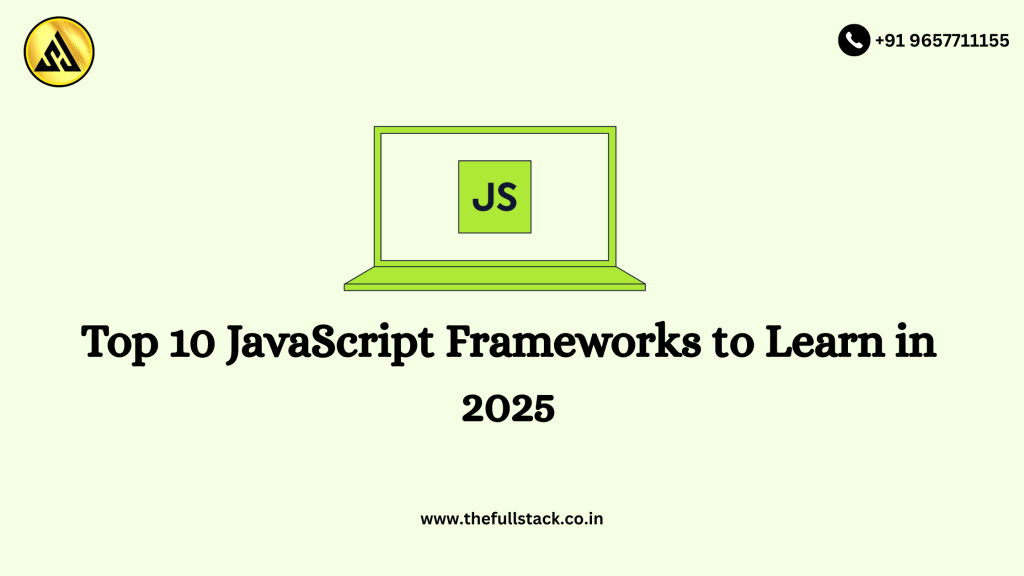JavaScript continues to rule the front-end jungle in the constantly changing field of web development, and its frameworks are the nimble instruments that programmers employ to create scalable, dynamic, and quick apps. Knowing which JavaScript frameworks to concentrate on in 2025 can provide you a significant advantage, regardless of your level of experience or desire to upgrade your stack or enter the workforce.
The Top 10 JavaScript Frameworks for 2025 are broken down below, along with practical examples to assist you select the best tool for the job.
🚀 1. React.js
Why Learn It?
React is still the most popular framework for creating dynamic user interfaces and single-page applications (SPAs), and it is supported by Meta (Facebook).
Use Case: Applied to websites such as Airbnb, Instagram, and WhatsApp Web.
Perfect for social networks, dashboards, and SPAs.
⚙️ 2. Next.js
Why Learn It?
Next.js extends React with built-in server-side rendering, static site generation, and API routes—making it ideal for SEO and performance.
Use Case:
Used by Netflix Jobs, Vercel, Hashnode.
Perfect for SEO-optimized blogs, e-commerce, and JAMstack apps.
🔁 3. Vue.js
Why Learn It?
Vue is simple, flexible, and has a gentle learning curve. It’s a great choice for startups and developers seeking a lightweight but powerful framework.
Use Case:
Used by Alibaba, Xiaomi, Grammarly.
Best for admin panels, small to medium-sized web apps.
📦 4. Nuxt.js
Why Learn It?
Built on top of Vue.js, Nuxt offers SSR, static generation, and excellent routing—all out of the box.
Use Case:
Used in creative portfolios, blogs, e-commerce.
Great for fast, SEO-friendly Vue-based applications.
🧠 5. Svelte
Why Learn It?
Svelte compiles into efficient JavaScript with zero runtime. It’s one of the fastest-growing frameworks due to its simplicity and speed.
Use Case:
Used by The New York Times and Storyblok.
Ideal for high-performance apps with minimal JavaScript footprint.
⚡ 6. Astro
Why Learn It?
Astro is focused on building content-rich static websites with zero JavaScript by default. It supports multiple frameworks like React, Vue, and Svelte.
Use Case:
Best for blogs, documentation sites, and marketing pages.
🌍 7. Remix
Why Learn It?
Remix is a full-stack React framework focused on performance and web standards. It’s built for fast, data-driven user interfaces.
Use Case:
Great for dynamic, modern web applications with advanced routing needs.
🌐 8. Gatsby.js
Why Learn It?
Gatsby uses React to generate static sites with GraphQL integration, making it suitable for fast-loading, SEO-friendly sites.
Use Case:
Used by IBM, Nike, and Impossible Foods.
Perfect for blogs, portfolios, landing pages.
🔄 9. Express.js (Node.js)
Why Learn It?
While not strictly a front-end framework, Express is essential in the JavaScript ecosystem for building robust backend APIs.
Use Case:
Used by Uber, Accenture, MySpace.
Ideal for RESTful APIs and full-stack web apps with MongoDB, React, and Node (MERN stack).
🧩 10. Alpine.js
Why Learn It?
Alpine is a lightweight framework for adding interactivity to HTML. Think of it as the “Tailwind of JavaScript.”
Use Case:
Best for adding simple interactivity to static HTML without a heavy framework like React or Vue.
Final Thoughts
Every framework has its own ecology, community support, and strong points. React and Next.js continue to rule the market if you’re looking for work. However, tools like Svelte, Astro, and Remix are revolutionizing performance and creativity.
🔑 Avoid attempting to master them all. Based on your desired development workflow, project type, and career objectives, pick one of these.
You may be like this:

